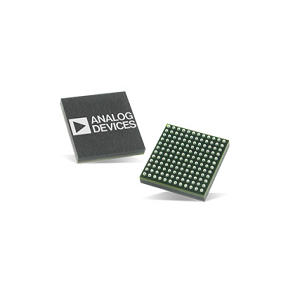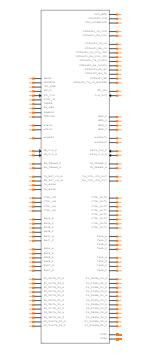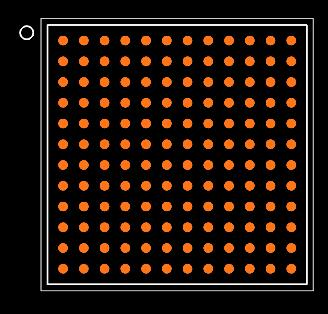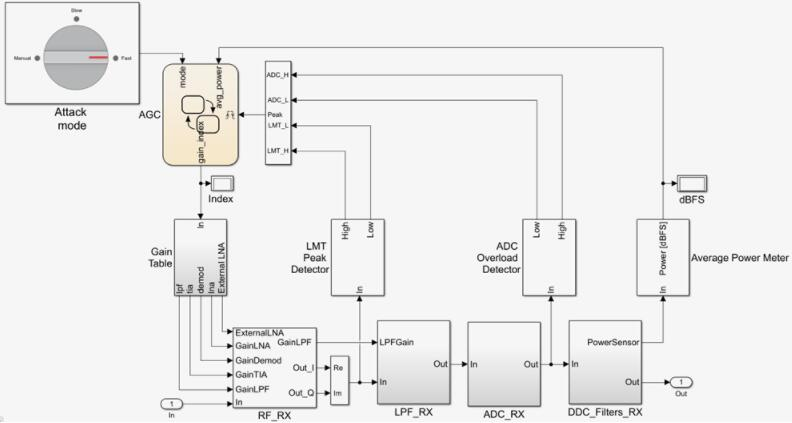AD9361: Features, Applications, and Datasheet
The AD9361 stands out as an advanced RF Agile Transceiver™ recognized for its remarkable performance, adaptability, and extensive bandwidth range, suiting it well for 3G and 4G base station applications. This article explores the intricate elements of the AD9361, emphasizing its unique features, benefits, and broad range of applications.Catalog

What is the AD9361?
The AD9361 stands out as a versatile RF Agile Transceiver, tailored for contemporary 3G and 4G base station ventures. Covering a wide frequency spectrum from 70MHz to 6.0GHz, it showcases its versatility and alignment with varied wireless communication demands. With the integration of an RF front end alongside flexible baseband and frequency synthesizers, design is streamlined, presenting a digital interface to processors. This efficient package, encased in a 10mm × 10mm, 144-ball CSP_BGA, caters to applications where space is at a premium. Encompassing a broad frequency spectrum, the AD9361 supports a multitude of transceiver applications, including base stations and cutting-edge wireless systems. Its programmable nature empowers to customize the device to precise specifications, enhancing the development process and boosting performance.
Channel bandwidths span from under 200 kHz to 56MHz, making the AD9361 suitable for a broad spectrum of applications. This bandwidth flexibility allows for effortless alignment with various communication norms, promoting efficient resource management. Field test emphasize how this adaptability enables swift and precise reactions to dynamic environments. The AD9361’s capability for digital interfacing with processors alleviates conventional challenges in RF design. By merging multiple functions into a single unit, it decreases the need for extra components, streamlining overall system design. This strategy often receives accolades within industry forums for its capacity to minimize costs and increase dependability by decreasing failure points.
AD9361 Symbol, Footprint, and CAD Model



AD9361 Specifications
Technical specifications, attributes, and parameters of the Analog Devices Inc. AD9361, along with parts comparable to the Analog Devices Inc. AD9361BBCZ.
|
Type |
Parameter |
|
Lifecycle Status |
PRODUCTION (Last Updated: 2 weeks ago) |
|
Contact Plating |
Copper, Silver, Tin |
|
Mounting Type |
Surface Mount |
|
Number of Pins |
144 |
|
Packaging |
Tray |
|
Pbfree Code |
no |
|
Moisture Sensitivity Level (MSL) |
3 (168 Hours) |
|
ECCN Code |
5A991.B |
|
Terminal Finish |
Tin/Silver/Copper (Sn/Ag/Cu0.5) |
|
Terminal Form |
BALL |
|
Number of Functions |
1 |
|
Terminal Pitch |
0.8mm |
|
Frequency |
70MHz–6GHz |
|
Base Part Number |
AD9361 |
|
Operating Supply Voltage |
1.3V |
|
Power - Output |
0.8mW |
|
Serial Interfaces |
SPI |
|
Current - Transmitting |
240mA~800mA |
|
Noise Figure |
2.5 dB |
|
Length |
10mm |
|
REACH SVHC |
No SVHC |
|
Lead Free |
Contains Lead |
|
Factory Lead Time |
8 Weeks |
|
Mount |
Surface Mount |
|
Package / Case |
144-LFBGA, CSPBGA |
|
Operating Temperature |
-40°C~85°C |
|
JESD-609 Code |
e1 |
|
Part Status |
Active |
|
Number of Terminations |
144 |
|
Type |
Tx-Rx Only |
|
Terminal Position |
BOTTOM |
|
Peak Reflow Temperature (Cel) |
260 |
|
Supply Voltage |
1.3V |
|
Depth |
10mm |
|
Time@Peak Reflow Temperature-Max (s) |
NOT SPECIFIED |
|
Pin Count |
144 |
|
Protocol |
LTE |
|
RF Family/Standard |
Cellular |
|
Current - Receiving |
175mA~445mA |
|
Number of Receivers |
2 |
|
Height |
1mm |
|
Width |
10mm |
|
RoHS Status |
RoHS Compliant |
Functional Block Diagram of AD9361

Features of AD9361
Adaptive Operation Modes
The transceiver accommodates both Time Division Duplex (TDD) and Frequency Division Duplex (FDD) operations, offering a versatile dual-mode. This flexibility allows seamless integration into diverse communication systems. From telecommunications to military applications, this adaptability enhances strategies in various challenging environments.
Extensive Channel Tunability
Channel tunability spans from less than 200 kHz to 56 MHz, offering impressive adaptability. This allows for tailored performance across different frequency bands: narrowband applications, and wideband applications. Technologies like LTE and 5G effectively utilize this tunability to optimize spectrum efficiency and minimize interference, which greatly enhances operational efficacy.
Enhanced Receiver Sensitivity
High receiver sensitivity plays a role in reliable signal detection, especially under challenging conditions. This feature is use in remote areas and rural regions. Such sensitivity is beneficial for maintaining strong connections, particularly good for communications in sectors like emergency services or remote healthcare monitoring.
Applications of AD9361
Versatile Communication Systems
The AD9361 is a core in point-to-point communication systems, celebrated for its remarkable adaptability. Its adeptness at managing a spectrum of frequencies and bandwidths renders it an optimal choice within these systems. Others frequently harness its integration potential to forge streamlined networks, enhancing both reliability and performance of the links. By judiciously optimizing resources, you can witness improvements in point-to-point connectivity.
Advanced Base Station Deployments
Within base stations, the AD9361 is distinguished by its resilience and outstanding performance metrics. It seamlessly integrates with various network standards, facilitating remarkable scalability and flexibility, two aspects that modern telecommunication infrastructure depends on. Many have gains in operational efficiency and a decrease in deployment expenditures by incorporating the AD9361 into their frameworks.
General-Purpose Radio Systems Development
The device's versatility also shines in general-purpose radio systems, where the demand for customization and adaptability is high. Others value the AD9361's capacity to manage multiple signal pathways simultaneously, paving the way for innovative radio solutions. Such integration plays a role in achieving superior signal clarity and efficiency, in today’s hyper-connected environment.
AD9361 Transmitter Model

Transmitter Component
The AD9361 transmitter model seamlessly integrates digital up-conversion, analog, and RF front-end filters to support efficient communication across various applications, creating a bridge between technology and interaction demands. Digital up-conversion transforms baseband signals to higher frequencies necessary for effective transmission. This process preserves signal integrity by minimizing distortion. The continuous evolution of digital signal processing is driven by industrial needs, aiming for precision and reliability in complex communication systems. Analog and RF front-end filters purify signals by eliminating unnecessary frequencies and reducing noise. They play a major role in ensuring clear communication over different distances, their efficiency repeatedly proven in environments. These elements enhance signal fidelity and system performance.
Tackling Nonlinearities and Gain Disparities
Nonlinearities and gain imbalances pose challenges in signal transmission. The AD9361 transmitter model employs sophisticated algorithms to address these, enabling peak performance. Innovative strategies grounded in empirical validation and rigorous field testing are employed for continuous parameter adjustments.
Fine-Tuning with Adjustable Attenuation
Adjustable attenuation allows precise control over signal power levels, enabling tailored transmission characteristics based on specific needs. This adaptability prevents data loss or interference, balancing signal strength. This approach, shaped by extensive feedback, matches contemporary demands for resilient and flexible communication systems. Effective attenuation management across diverse communication platforms upholds system integrity and efficiency. Customizable settings align with various operational conditions, while field trials in dynamic settings underline the role of adjustable attenuation in modern systems.
AD9361 Receiver Model

The architecture of the AD9361 receiver resonates with that of its transmitter counterpart, focusing on adept noise control and sustaining a broad dynamic range. This harmony involves applying intricate filtering and attenuation techniques, aimed at safeguarding signal purity. Reducing noise enhances the clarity of received signals. The use of advanced filters aids in distinguishing the desired signal from surrounding noise. Moreover, adaptive filtering strategies provide the flexibility for on-the-fly adjustments to changing noise environments, thereby improving stability. Maintaining an extensive dynamic range is integral to the receiver's performance. Automatic gain control (AGC) systems enable the receiver to adjust to varying signal strengths, aiming to diminish distortion while enhancing data precision. Others commonly implement AGC in intricate environments to sustain signal excellence.
Dimensions of AD9361

AD9361 Manufacturer Information
Analog Devices has garnered recognition for its expertise in merging analog and digital signal processing. It offers groundbreaking solutions that translate complex phenomena into practical electrical data, driving forward electronic applications. The company's dedication to quality and pioneering technology places it at the forefront of industry evolution, eliciting both respect and a sense of admiration. Through the AD9361, Analog Devices highlights its influential role in empowering technologies that transcend conventional boundaries. As industries evolve, the thirst for adaptable and effective signal processing solutions will inevitably rise, with the AD9361 standing as an important element for future innovation, fostering a sense of anticipation and forward-thinking exploration.
Datasheet PDF
AD9361 Datasheets:
Frequently Asked Questions [FAQ]
1. What are the roles played by the AD9361?
The AD9361 is crafted to serve a wide range of radio frequency needs, offering strong capabilities in both modulation and network adaptability. With its high integration and excellent performance, it fits seamlessly into contemporary communication frameworks. In practical terms, the chip helps consolidate design processes by integrating various functionalities into a single package. This reduction in complexity contributes to improved reliability in devices like software-defined radios and MIMO systems. Its flexibility becomes particularly influential in scenarios requiring quick adjustments to evolving network standards.
2. Can you define an agile transceiver?
An agile transceiver merges a radio frequency front-end with a programmable baseband, greatly facilitating the design processes for current digital processors or field-programmable gate arrays (FPGAs). These transceivers provide latitude in crafting and deploying communication systems, thanks to their ability to undergo dynamic reconfiguration to meet the demands of different communication protocols. For example, network equipment manufacturers find they can swiftly bring products to market, economizing by altering transceiver functions through software updates instead of hardware changes.
3. In what way does the AD9361 function?
The AD9361 functions across a wide frequency range, spanning from 70 MHz to 6 GHz, creating a streamlined method for crafting RF transceivers. It incorporates a mixed-signal baseband with frequency synthesizers, enabling it to cover a diverse spectrum of frequency bands. This consolidation helps to decrease the number of external parts required, fostering more compact and energy-conserving designs. Given its diverse capabilities, the AD9361 is applied in various fields, such as mobile base stations and aerospace technology, where dynamic and steadfast wireless communication holds value. Many have noted its proficiency in quickly adapting to shifts in frequency and simultaneously supporting multiple channels, presenting notable operational benefits in swiftly progressing technological domains.